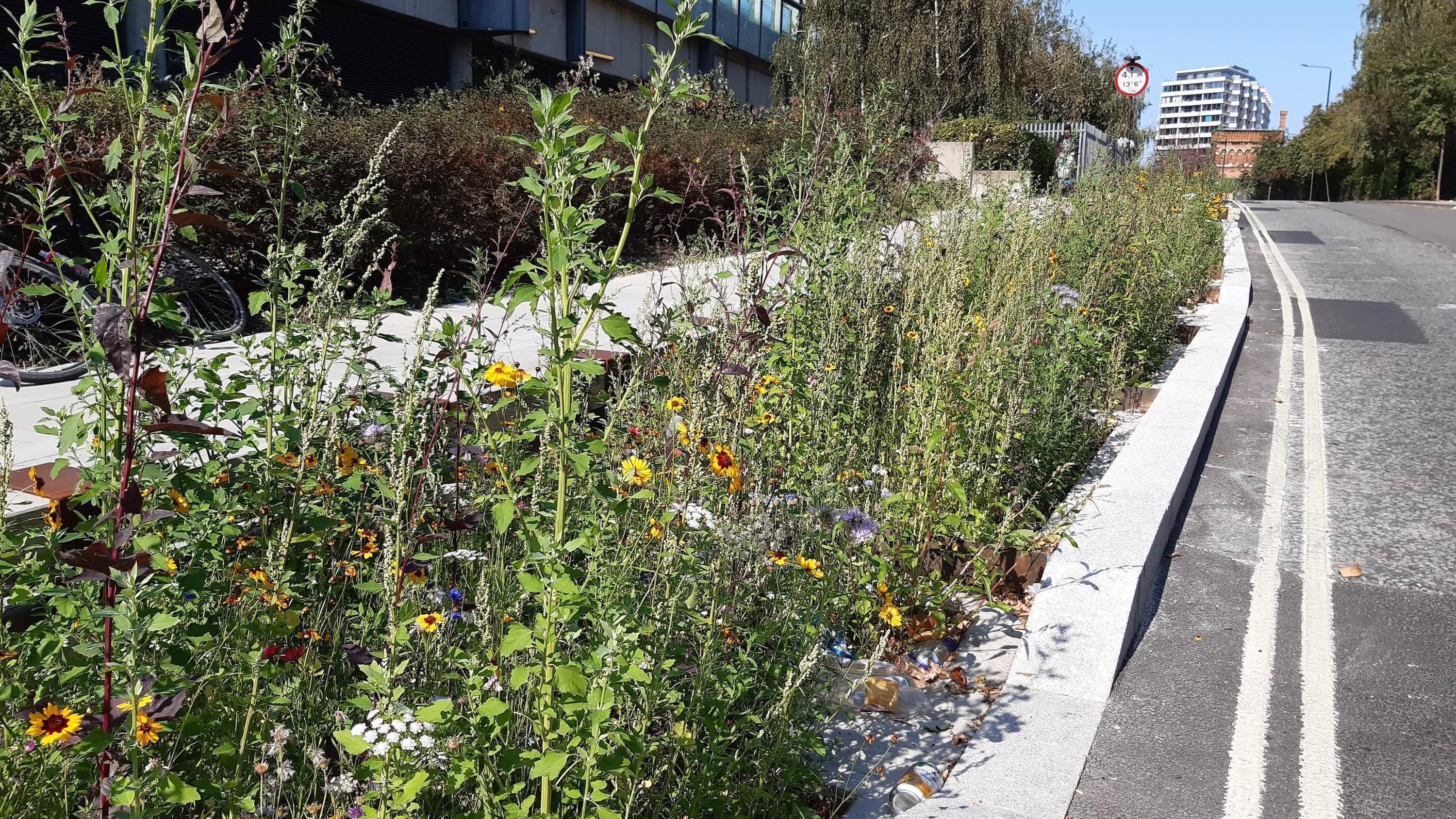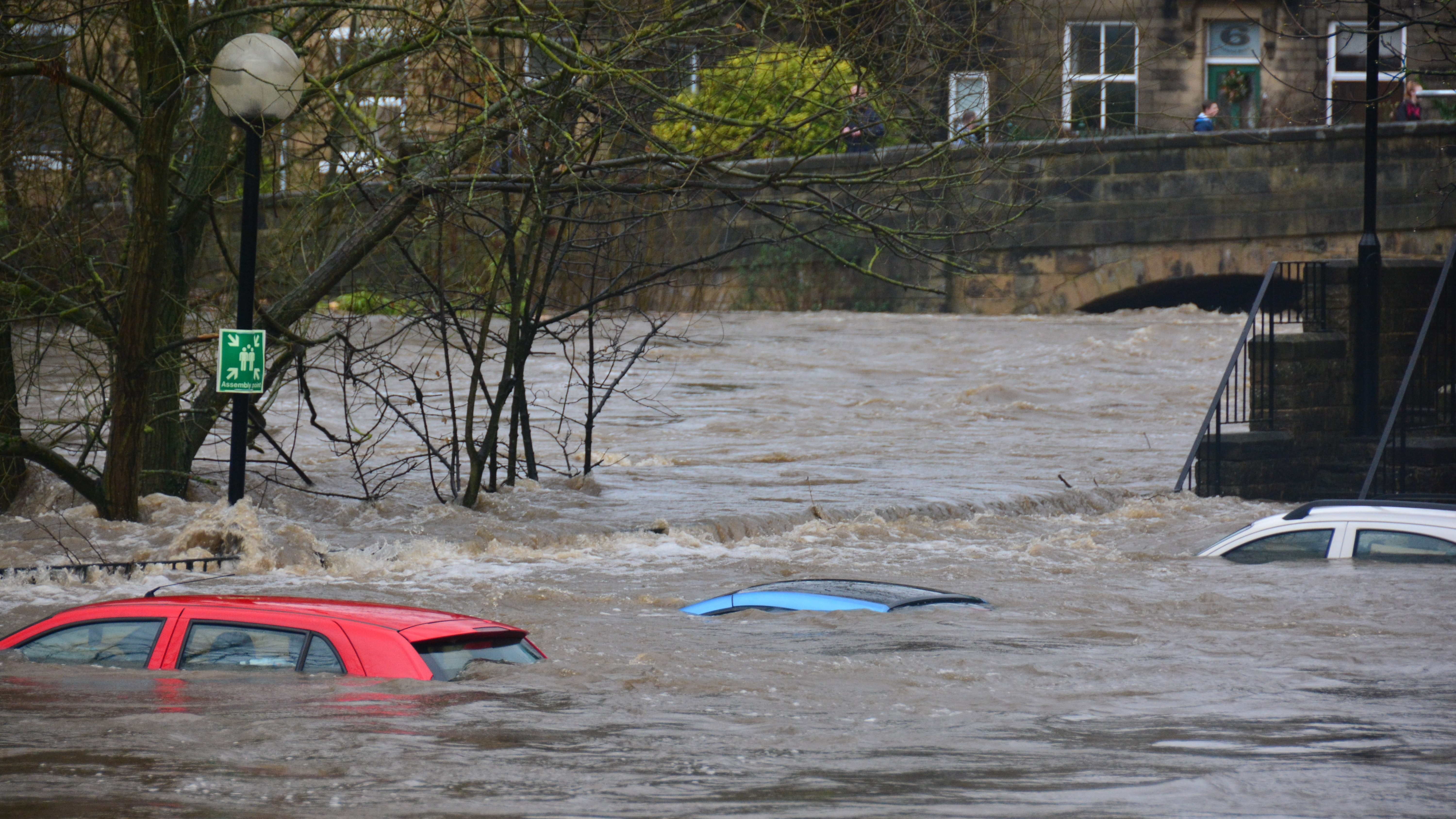
Camley Street, Camden with temporary wildflower planting © Kevin Barton, Robert Bray Associates
According to the Environment Agency, around 235,000 residential properties in London are at a high risk of surface water flooding. Given the changing climate, this figure is predicted to rise.
November's COP26 summit emphasised the urgency of reducing emissions to limit global temperature rise to 1.5C. Among the goals it set, it called on countries to present 'ambitious 2030 emission reduction targets that align with reaching net zero by the middle of the century' – and to adapt to protect communities and natural habitats.
Maximising use of SuDS to minimise risk
One particular threat to communities is flooding: we have already experienced increased risk of this in London from short-duration, high-intensity rainfall.
Sustainable urban drainage systems (SuDS) can reduce flood risk by managing drainage in and around properties and other developments. SuDS work by slowing and holding back the water that runs off a site, allowing natural processes to break down pollutants. They also offer wider benefits, which include reducing carbon dioxide, improving biodiversity, keeping urban heat down and promoting health and well-being, to name but a few.
Traditional schemes aimed at reducing flood risk have tended to take a storage-based approach, constructing large ponds and above-ground attenuation. Once a rainfall event causes flooding, the catchment is identified; potential schemes are then scoped, often using existing public green space such as parks, before being implemented. In some urban settings, where land was not available for systems on the surface, underground storage tanks have been constructed.
To date, these schemes have sourced funding from the Flood Defence Grant in Aid (FD-GiA), allocated by the Environment Agency. While FD-GiA actively supports SuDS implementation, small-scale localised SuDS are not considered of sufficient benefit to be considered for individual grants. The amount that a project can secure from the fund depends largely on the number of residential households protected.
Construction of traditional, large-scale schemes is a long process – taking a number of years at best – and not simple. Many projects are designed but cannot then be implemented because of their high cost, limited benefits and space constraints.
Furthermore, planning schemes only once flooding has taken place is a reactive approach. London instead needs a proactive strategy that implements SuDS in the best locations to maximise their benefits, including reducing flood risk.
London pilot investigates value of smaller SuDS
The concept of the London Strategic SuDS Pilot (LSSP) was approved by the Thames Regional Flood and Coastal Committee (TRFCC) in 2017 to prove the viability of such an alternative approach to flood risk management.
While traditional schemes have benefited many communities, there are urban areas where sufficient land cannot be found, or a scheme has already been implemented and the residual flood risk remains unacceptably high. This study sets out to implement small-scale SuDS, and prove that, distributed at scale across a catchment, they will collectively maximise flood risk reduction.
The approach was devised following the construction of the Firs Farm Wetlands in Enfield, London consisting of a combined wetlands and flood storage area that mitigates the impact of surface water flooding and diffuse urban pollution. It provided 30,000m3 of above-ground attenuation and opened up sections of the culverted Moore Brook, significantly improving biodiversity and amenity value.
The challenge at Firs Farm was that flood risk to properties in the catchment remained high after the scheme was implemented. The question that the LSSP study team asked was whether distributed SuDS could be the key to reducing the residual flood risk further, by providing a greater benefit more efficiently, and attract further FD-GiA. To answer this, collaboration was essential.
In total, 18 organisations came together to answer this question including independent Thames flood advisers, Arcadis, seven London boroughs – Camden, Enfield, Hammersmith & Fulham, Hillingdon, Kingston, Southwark, and Westminster – as well as Thames Water, the Greater London Authority and Transport for London.
Modelling helps identify potential sites
Our aim was to understand potential locations for distributed SuDS that would reduce flood risk the most. We developed various scenarios that would allow us to optimise the systems' hydraulics according to altitude, SuDS type, third-party collaboration and so on.
It was essential to integrate geographic information systems and hydraulic modelling software to assess different SuDS types in different places and understand where best to put them. The first phase of modelling considered specific features at defined locations in key areas of the outer London boroughs Enfield, Hillingdon and Kingston, and a second phase looked at the whole of Camden, Westminster and Southwark.
In phase two, location was more relevant than the SuDS type. By running a series of scenarios that differed in terms of the number of SuDS features implemented and location, we identified that flood risk could be reduced by 63% by selecting and implementing the top 5% of SuDS opportunities. The next 20% of SuDS opportunities would reduce the risk by a further 26%. These percentages clearly show why we need to optimise SuDS implementation locations.
Using this analysis, along with a cost model we built and an assessment of the benefits of a combination of features, we believe that £35m of capital investment in SuDS could yield £190m in flood risk damage reduction, as well as £40m in natural capital value on average per London borough. Wider benefits were assessed using the Benefits Estimation Tool, B£ST.
'Our aim was to understand potential locations for distributed SuDS that would reduce flood risk the most'
Key results from LSSP economic calculations
-
The average cost ranges of implementing potential SuDS features are: 5% of all possible interventions = £25m–£43m; 25% of all possible interventions = £125m–£217m; 100% of all possible interventions = £530m–£870m.
-
Based on realisation levels of 5% and 25%, the average cost–benefit ratios for direct procurement range from 1:2 to 1:11.
-
For opportunistic implementation alongside other works for the same realisation levels, the average cost–benefit ratios range from 1:4 to 1:15.
-
The average cost of modelling a London borough ranges from £20k to £50k.
-
An average increase in benefits realised of £18m per year can be achieved by optimising implementation rather than taking an opportunistic approach.
Our modelling also determined that this approach would generate capacity in London’s Victorian combined sewer system, and would therefore be an excellent way to offset the impact of climate change on this network.
Completion of modelling in advance also means that practitioners can quickly ascertain suitability should any opportunities arise later to implement SuDS alongside or incorporating into other programmes of work such as infrastructure upgrades (such as mains replacement works for water, gas, electricity, or improvements to roads and/or cycle networks) or public realm enhancement (e.g. pedestrianised areas and public parks).
The modelling continues to be enhanced. We are extending the approach to cover the entire borough of Enfield as well as Lambeth, and actively seeking partnership with other lead local flood authorities in the TRFCC outside London.
Boroughs show way to SuDS success
As well as modelling, implementing SuDS was a primary aim for the LSSP. To achieve this, the City of Westminster, the London boroughs of Camden, Enfield, Hillingdon and Southwark, and the Royal Borough of Kingston upon Thames were selected, and each individually led on the implementation of their respective schemes.
This allowed those with local knowledge to decide the most appropriate locations for SuDS. In addition, it was an opportunity to compare the success of different organisations, given that funding was made available for each project.
The London Borough of Hillingdon's SuDS scheme in Field End Road, Eastcote consisted of rain gardens constructed in the existing reservations between the main and side road carriageways and raised planters on the footpaths. This increased the amount of green space and enhanced the amenity of the area.
Such gardens are small areas into which rainwater from hard surfaces such as roofs and roads can drain. They take the rainwater into the ground, though in areas where soil permeability is low they often connect back into land drains or sewers.
The Eastcote scheme has won multiple awards, including the Institution of Civil Engineers (ICE) London People's Choice Award in 2020, and another for Excellence in Flood and Water Management at the 2020 Landscape Institute Awards.
Meanwhile, the London Borough of Enfield and partners implemented a series of rain gardens in the Haselbury neighbourhood areas of the Moore Brook catchment. They constructed 50 gardens and other SuDS features in Haselbury, working collaboratively with campaign group Cycle Enfield and the council's own Quieter Neighbourhood team.
Camden also installed a series of cascading rain gardens and tree pits along the kerb line of Camley Street, next to St Pancras International train station. It planted a mixture of herbaceous grasses and perennials to provide dense foliage and a high degree of filtration, greening an otherwise grey street.
SuDS in the remaining three boroughs are currently being designed, with Kingston finalising its plans for a dispersed SuDS at Acre Road.
Southwark meanwhile has been installing SuDS at three separate sites. It is using blue–green roofs at Lewes House, and repurposing a cul-de-sac on Melior Street to take road and roof run-off into rain gardens and below-ground storage tanks. Around the corner on Snowsfield, highway run-off is directed into a rain garden on the edge of the carriageway. This site, outside Snowsfield Primary School, offers additional green space and amenity between the road and footpath.
In Westminster, Transport for London (TfL) is likewise finalising a design that will repurpose access ramps for a pedestrian underpass at the junction of Edgware Road and the Westway, next to Edgware Road Underground Station. With the underpass due to be abandoned as part of a wider initiative for safe pedestrian crossings, the ramps will be converted into SuDS basins, and surface water will be directed from the adjacent footways and carriageway into the basins. These will collect rainwater and slowly drain it into the underground sewer network. The basins will have street-level planting that will improve visual amenity and biodiversity, while also providing shading and helping to reduce the urban heat island effect.
The LSSP itself and these schemes were alike funded by the TRFCC and Thames Water. Our aim, as with the modelling, is to ensure that all implementation is economically beneficial, and funds are available to deploy SuDS quickly alongside other investment as opportunities as they arise. This could be street works, utility work or transport improvements.
Thames Water has recently partnered with Thames21 and the University of East London to monitor the performance of these SuDS. Our interest is not only in the schemes' physical effectiveness, in terms of flow and environmental enhancement, but also public perception of and attitudes towards SuDS features and the organisations that provide them.
The response from others has been humbling. This project won the 2021 Environment Agency Flood and Coast Excellence Award in the surface water management category. It was also mentioned in section 11 of the agency's 2020 Environmental Performance Report for England, highlighting our collaborative approach.
Pilot looks to wider distribution
The methodology established and refined by the LSSP can be used in other urban areas. The process of modelling a catchment for the purposes of implementing distributed SuDS can also be adopted elsewhere.
This should enable other authorities responsible for risk management to identify and prioritise the opportunities in their catchments. Furthermore, the economic evaluation carried out in the modelling can encourage other LLFAs to implement distributed SuDS.
Graeme Kasselman is the waste water planning system lead for the Tidal Thames at Thames Water
Contact Graeme: Email
Craig Boorman is delivery manager, drainage and wastewater management plan at Thames Water
Contact Craig: Email
Related competencies include: Planning and development management, Sustainability

